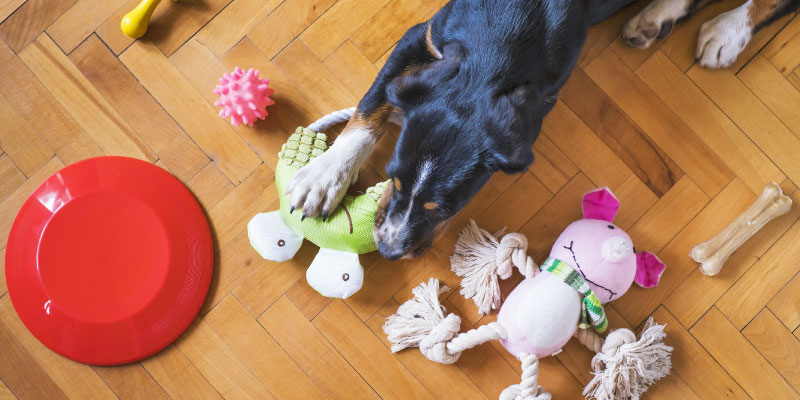Taking on a dog is one heck of a commitment – not just to giving a dependant your love and attention every day, but to taking regular walks.
For whatever reason (usually the wonderfully unpredictable weather or simply changing circumstance), sometimes it’s just not appropriate to go outside.

So, how can we keep our dogs healthy if we can’t get out? What indoor exercises can you do with your dog to keep them healthy, whether you live in a flat or a house with a garden?
We take you through some of the best indoor exercises for dogs you can do when you are stuck at home.
How much exercise does my dog need?
First things first – no two dog breeds are the same when it comes to the best indoor dog exercises. We need to consider a number of factors, such as your dog’s age, breed and current activity levels.
As always, you should check with your vet before you embark on any new dog exercises regime. Your indoor routine should not be vastly different in terms of effort and calorie expenditure than his or her’s outdoor one.
Generally, a good rule of thumb is the following:
- Small breeds such as Yorkshire Terrier, King Charles Spaniel, Chihuahua and Papillon dogs need about half an hour per day, plus playtime.
- Medium breeds such as Shetland Sheepdog, Miniature Schnauzer, Whippets and Pugs can have one hour or a little over.
- Bigger, athletic breeds like Border Collies, German Shepherds, Siberian Huskies and Golden Retrievers may need two hours or more.
- Extra Large breeds such as Irish Wolfhounds, Great Danes and St Bernards really depends on the breed. Most probably don’t need more than 40 minutes to an hour at a time, so you don’t put extra pressure on their joints.
It’s best to stagger this exercise over the day than try to fit it all in at once.
Don’t attempt these times until your dog has reached adulthood – generally around a year to 15 months.
Best indoor dog workouts for your pup
Working out with your dog not only keeps you and your pet fit, but it also strengthens your bond. To get the best out of that parent and pooch relationship, try these proven methods to exercise dogs indoors.
Go up and down the stairs
We’ll go in head-first with this hardcore workout. Your thighs will thank you later! Please note, this one’s not recommended for older dogs or those with joint and muscle issues.
However, if your pup is fairly young, fit and spritely, try excitedly running up and down the stairs a few times until you’re both panting.
This helps to strengthen the back legs and improve agility. Just keep an eye out for any hazards, like children’s toys, shoes and space. Only try this if you have space and don’t go so fast you trip over each other.
Think of it more as marching energetically than running.
Hide and seek
Speaking of children, this one is a great way to get the kids involved.
You can all hide around the house and call out your pup’s name. Whoever is found first is the winner! It’s also a test of your dog’s obedience as he has to wait patiently until he is called.
If you don’t think your dog will wait, have someone hold him, and then go searching with your dog. Try and be silent, and let the children’s call get your pooch excited to reunite the family together.
Alternatively, if there aren’t many of you, try hiding treats or a favourite around your house and use the ‘Go Find’ command.
This will test your dog’s fitness and homing capabilities. You will have to build up this exercise by making it easy to find at first and then build up to trickier hides.
Set up an obstacle course
You don’t always need fancy indoor dog exercise equipment to keep your pup active, but dog toys certainly help. If they’re in short supply, set up a dog obstacle course using chairs, hula hoops, tables, and boxes – anything that encourages them to walk around objects and experiment with different levels.
Just don’t force them onto an object they are uncomfortable with. This exercise should be fun, and ideally, you should be able to ‘lead’ them around the course using a treat. So if you can’t do it, don’t expect them to do it. Keep it safe.
Think using soft toys instead of cones, their raised dog bed to climb in and out of on command, or a sturdy big box to use as a tunnel, and hula hoop to jump through.
You’ll be surprised how many children toys can double as dog obstacle courses.
Tug, fetch and catch
There’s no reason why you can’t take your favourite outdoor activities inside! Tug is great for those with dog toys. Play lightly – refrain from pulling back, and let your dog have control. Otherwise, you risk encouraging aggressive behaviour.
Alternatively, if you have more than one dog, they can both pull on the toy. Keep it light though, keep it fun with treats, and stop it if the dogs start to show aggressive or possessive behaviour.
Fetch is a slightly riskier one, but good if you have a larger living space or garden. Clear away all hazards like lamps and other electrical appliances. Your dog may eventually learn to predict your throw and catch it midair, which is even better and safer for your glassware.
Don’t throw too hard, to begin with, do small throws– it’s best to keep little children away from this one.
Try gentle swimming and water play
This is obviously only for smaller breeds unless you happen to have a large swimming pool that you don’t mind the dog sharing! But most dogs will love jumping and splashing in a child’s paddling pool or running through the sprinklers. You don’t need a big house to get one of those out in the yard.
If you do have a pool or pond they can run in and jump, encourage them to use all four limbs by gently guiding them in the shallow water.
Try to maintain a sense of calm at all times, or your dog may develop a fear of water. Don’t push it if they are not comfortable, remember this is about having fun.
Use your own gym equipment
If you’re lucky enough to have a treadmill at home, it doesn’t have to be exclusive to you. Keep it on a super slow setting and encourage your dog to get on by placing treats at the end. Let your dog walk without a leash.
If you find that they are comfortable with the treadmill, or feel like your dog needs more exercise than you can give them, it may be worth investing in your own specialised doggy treadmills, especially if you want to do this regularly.
It’s not a cheap option, but it may be a long-term solution if you need to exercise your dog indoors regularly. Just remember this can’t replace all exercise forever, dogs will need to go outside and play.
They need variety as much as we do. But it can help get your through difficult days and get rid of any excess energy if all you can do is one walk a day, and your dog really needs two.
Get other dogs involved!
Happiness is only real if shared, right? To change things up, invite a family member or friend over with their own dog and watch how they interact with one another.
Intervene if you think they’re getting too aggressive or even a little “too close”. Most dogs will suss each other out with a gentle sniff before they get involved in play.
A good rule of thumb is to meet the dogs outside of the shared home, give them a moment to meet on the lead, and if they seem happy enough, bring them into a shared space together.
Dogs of similar size, age and temperament will generally play better today. So think of socialising Pomeranian and Yorkshire Terriers, 2-year-old dogs with dogs of up to 6 years, Golden Retrievers with Standard Size Poodles etc…
What about exercising my dog’s brain?
Just like us, dogs need mental stimulation to keep their minds active and delay the onset of dementia. Akin to dementia or Alzheimer’s in humans, dogs can develop Canine Cognitive Dysfunction Syndrome.
This may present as confusion and anxiety, so it’s best to keep them sharp right through to old age – particularly if they can’t move like they used to.
How to stimulate your dog’s cognitive function
Naturally, the best way to train a dog is to reward it with food. Try to break up your dog’s daily feed so that you’re not overfeeding, or ask your vet about how many treats are optimum.
Almost any behaviour you can get your dog to do in order to get food can be considered a fun game.
You don’t even have to try commands at first. Try rolling a piece of food on the floor and watch them chase it. Or between your legs as the chase the food through your legs.
How about throwing the food in the air and letting them catch it, or getting them to chase you around tables, chairs or the garden and reward them when they ‘catch’ you. Change direction, be active and unexpected.
Use their kibble for this, you don’t need to always use the expensive treats. Just normal dog food can be used for rewards, especially if you are doing it through play.
Snuffle mats and licky mats
Getting your dog to ‘hunt’ down his food using his nose can be very rewarding. You can create or buy your own snuffle mat dog toy, or simply use the grass in your garden. Scatter some of their kibbles and let them sniff it down. Don’t go crazy, do it in small handfuls.
You don’t want to have so much on the ground that you are feeding the foxes, coyotes and dingos.
Alternative you have licky mats which you press soft food onto and let the dog lick clean in-between the little nips. It’s soothing and takes time for them to eat it.
Which Hand?
The Which Hand game is pretty simple. Start with your hands behind your back, with a treat in one clenched fist.
Put your hands out in front of you and encourage your dog to guess which hand the treat is in, using his nose only. A correct guess wins the treat – if not, try again until pooch wins!
Hidden treats
This one takes Which Hand up a level. Think of it as a magic trick for kids. Take three identical bowls or cups and hide a treat underneath one of them.
Then shuffle them to see if your dog can remember where the treat is or sniff them out. This is a great cognitive exercise, not to mention a good workout for the nose!
Refresh the obedience training
When the rain keeps us locked indoors, we can still make the most of bonding time with the pooch. Use this time to refresh your dog’s memory on obedience training, or even start teaching them slightly more advanced dog tricks.
Encourage positive reinforcement by rewarding him with treats for sitting, rolling over or giving you his paw. When you’ve got that nailed, take it up a notch – you can even encourage your dog to bring you the newspaper, though this may take some time.
Brain, body and spirit – why exercise always wins
There is myriad evidence to suggest the tremendous benefits of exercise for our mental health. Coupled with this, social interaction helps us to produce “happy hormones” which are mimicked in your dog’s behaviour.
By encouraging your dog to keep his mind and body active in the home, you’ll improve your friendship and note a marked improvement in overall happiness and obedience.
Rain or shine, there’s always a good excuse to get active with your pup. Get the kids involved, ask the adults or even other dogs. They’ll always appreciate the opportunity to play!




